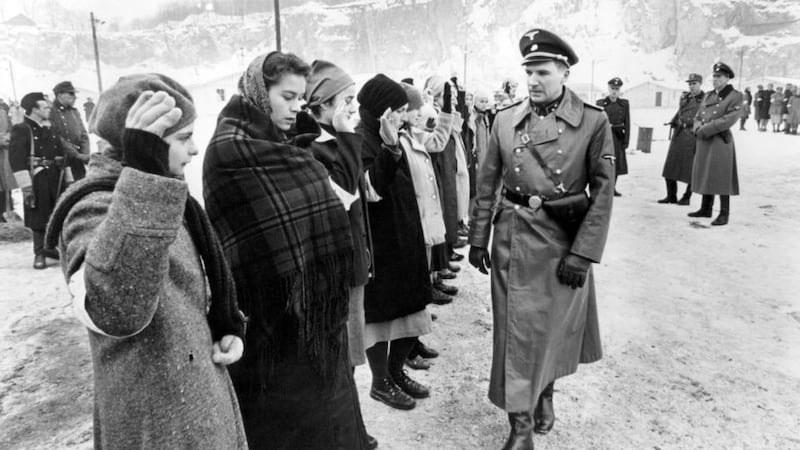Thomas Keneally, on the other side of the world from his home on the North Head of Sydney Harbour, being bustled from reception to lunch to meeting to interview, and about to embark on a research trip to uncover more of his Cork heritage, bursts into the tiny and darkly glamorous 1824 Bar at the Shelbourne Hotel and begins on a rake of gossipy stories before I even have time to turn on my tape recorder.
At 87, with well in excess of 50 books to his name including the Booker Prize-winning Schindler’s Ark and, most recently, Fanatic Heart, the story of Young Irelander John Mitchel, Keneally is not a man to take things slowly. And why should he be? He has a lot of things to say.
He’s accompanied by his wife, Judy, whom I briefly ask how difficult it will be to get a word in. Does she have trouble? Apparently not, according to her husband: “You know those Wolfpack submarines that used to bring down tankers in the convoys in World War II? Well, Judy’s torpedoes get you right between the comma and the connective article... and the tanker goes up in a sheet of flame.”
Keneally’s chance encounter with Leopold Pfefferberg changed his life, but it had hardly been undistinguished up to that point
Among the many unexpected things I learn during our breakneck and frequently riotous conversation is that Steven Spielberg, legend of cinema though he is, listens to advice. Keneally, as fond of digression and anecdote in person as he is in his work, is telling me about his countryman Fred Schepisi, who directed an adaptation of Keneally’s novel The Chant of Jimmie Blacksmith as well films including Roxanne, Plenty and Last Orders.
READ MORE
He is also responsible, Keneally tells me, for introducing Meryl Streep to Australian Rules football, which the author knows because she asked him, “do you follow the same crazy football as Fred makes us watch?”
During the filming of John le Carré’s The Russia House, Schepisi found himself lunching with star Sean Connery, by the end of which they were both “perfectly stewed”. Filled with joie de vivre, Connery asks Schepisi to tag along to a party at Steven Spielberg’s house. It is the late 1980s and Spielberg already has ET, Jaws, Close Encounters of the Third Kind and Indiana Jones under his belt, none of which prevents his fellow director – “still tanked” – from buttonholing him with a few words of wisdom.
This film Schindler’s List, says Schepisi, you should produce it and you should let me direct. There are too many crowd scenes, too many party scenes and, let’s face it, you’re no good at them; you want to shoot everything from above. In fact, he goes on in Keneally’s retelling, “You just have everyone yelling at the top of their voice. You make party scenes like a Coke drinker.” Keneally draws closer, eyes glittering. “Which is the truth, actually,” he says, “absolutely on the money.”
Forward to Keneally and Spielberg on the set of Schindler’s List in Poland, contemplating a crowd scene. Spielberg turns to the novelist and says, “I’d love to use a crane shot here. But your mate Schepisi wouldn’t like it.”
None of which gallery obscures Keneally’s deep regard for Spielberg, with whom he enjoyed a career-defining collaboration – and one that wouldn’t have happened without a third man, one Leopold “Poldek” Pfefferberg, a Polish former teacher and ex-army officer whom Keneally encountered in 1980 in Pfefferberg’s leather goods shop in Beverly Hills, in search of a briefcase.
As they fell into talk and Pfefferberg learned that his customer was a novelist, he began to tell his extraordinary tale: how he and his wife Mila, both Jews, had escaped deportation to Auschwitz via the protection of businessman Oskar Schindler. Two years after their first meeting, Keneally published Schindler’s Ark which, as the fourth of his novels to be shortlisted, won the 1982 Booker Prize.
“I looked at him and I thought, here’s a man on what’s supposed to be a death list,” Keneally remembers. “There were Europeans who believed that he must die for the future of Europe, that Europe couldn’t be healthy with him breathing. So there were people who wanted desperately to take his oxygen away, and to leave him a corpse when he was a kid. And I’d never met anyone like that before so intimately.”
Keneally paints a vivid picture of the charismatic Poldek, who on their travels together would charm airline staff into magicking up seats on planes (“Darling, do you mind lifting your chin? Darling, what are you doing behind the desk? The camera would love you. And so would I, except I’m a married man. Now can you fix up our reservation?”) and urged Keneally’s publishers to throw their weight behind the novel when he heard they were printing only 30,000 hardback copies (“Are you mad? Are you crazy? You will need 10 times that. And he was right”).
Crucially, he also knew Steven Spielberg’s mother and, as Keneally points out, “get the mother’s ear and you’ve got the clan.” At the time, he tells me, film studios were wary of projects about the Holocaust, believing the material too traumatic to attract audiences and, consequently, uncommercial. But Poldek persevered, badgering the head of Universal Studios (“I’ve just told Sid Sheinberg he’s crazy!”) until Spielberg was given the green light and a modest budget. The film was released in 1993, and went on to win seven Oscars, and nominations for actors Liam Neeson and Ralph Fiennes. Poldek had prevailed.
Keneally’s chance encounter with Leopold Pfefferberg changed his life, but it had hardly been undistinguished up to that point – although, he maintains, his grandparents might not have agreed. When he received Ireland’s Presidential Distinguished Service Award in 2014, a recognition of his involvement in the diaspora that he describes as a treasure he’ll take to his grave, he was tickled by imagining his forebears’ reaction to the honour bestowed on “their snotty little grandchild, their least promising grandchild ... And it’s beyond belief to me too.”
Why, when he has achieved so much, was he seen as the least promising? He was, he replies, “a bit dyslexic” and, generally, not a great performer at school – unregarded by “a jury of harpies”, as he thinks of the Dominican nuns in charge of the classroom, and taunted by the schoolgirls who’d rat on him when he – frequently – spilled his ink. His imagination languished in the face of creative writing assignments set by the Christian Brothers – “a page and a half on my summer holiday or why it’s better to live in the country than the city. They were specialists at dreaming up non-narrative and uncontroversial subjects, in which you were least likely to mention bosoms or underwear.”
And yet, he was drawn to writing, and as a little boy wrote a narrative of his Confirmation for his father, who was overseas with the Australian air force (“How Irish can you get?” he says of his first novella). He formed a playground storytelling circle with a group of boys, although they were eventually closed down by the headmaster whom, he suspects, “thought I might be telling improper stories. I didn’t know enough. They didn’t tell us enough to tell an improper story!”
Tom Keneally’s educational teething troubles were vastly improved when he had an epiphany as one of the brothers was at the blackboard explaining Pythagoras’s theorem. “I understood it in a rush, it was like a revelation. I didn’t work it out, the whole package came to me, and from then on, I started to become a bit of a scholar,” he remembers, a relief because his mother was immensely keen on her progeny learning all they could.
“She had had to leave school at the end of year six, as most Australians did then in the bush, and she resented it profoundly. And she was a woman who under different stars, if she were around now, she’d be a lethal attacking lawyer. But in any case, she would get upset if my report wasn’t good. So if I wanted her not to be upset, I had to appear to learn the rituals. I learned how to look clever. And that’s a skill you can pick up: to be a bullsh*t artist, I suppose.”
It’s not uncommon, I say, for the more self-deprecating writers to think of themselves as bullsh*t artists. Does he? He roars with laughter and looks across at Judy conspiratorially.
“Well, it’s hard,” he replies. “Judy has to moderate my narrative style, which is long-winded.” Once again, he invokes his mother who, he says, would begin the story of someone’s hernia operation with the Macleay floods of 1887, continuing via updates of the patient’s other family members, house moves and health scares. “So my mother was a novelist. And my father was a script writer. He wanted to get right to the action. And occasionally he’d say, to short-circuit my mother’s narration, ‘Anyway, he bloody died.’ And that didn’t stop my mother at all. She’d chastise him for interrupting. And then she’d start up with her genealogies, her intergenerational stories. And so that’s very novel-like, and I take after her and Judy has to watch me because I can go on. And now I’m old, it’s worse.”
‘I’m scared of poverty, and of not having a home. That at this age, I could not find my own home’
Further captivating details of his father include his prowess as a sportsman. “He was by nature a faction fighter and a footballer. He played rugby league, we were keen on rugby league in New South Wales. And he was the sort of rugby league player who, if things weren’t going fast enough he would, as all men would tell me for the rest of my life, come the knuckle: he would start a fight to get everyone’s spirits up. And during a fight, that he started, he was behaving like a choirboy, because he had a choirboy face and the soul of a sociopath.”
Both he and Judy have genealogies and intergenerational stories that link them to Ireland; for Keneally, Newmarket in North Cork, and for Judy, east Galway, where her great-grandfather was a Ribbonman who was sent to Australia for life. Judy’s great-grandmother – “with whom I’m rather in love”, says Keneally – was held in one of Australia’s “female factories”, prisons for transported women convicts, for several years before being released with 10 shillings to go to an employer in the bush. Keneally plans to write a novel based on such institutions that will shed light on the travails of women prisoners, whom he notes were frequently written off as prostitutes and had to use all their wit and skill to negotiate their way into a new life.
Judy’s great-grandfather married this alumna of the female factory, but had left a wife back in Ireland, whose fate is unknown – a “phantom great-granny”, as Keneally describes her, who might have died or emigrated to New York or to Liverpool. But the memory produces another tale from history, that of an Irish convict of the time who used to forge postmarks and letters carrying the news of a wife in Ireland’s demise, so that her husband, now deep in the Australian bush, would be free to remarry. In the letters, he would also include the information that “your wife died in the bosom of the Holy Catholic and Apostolic Church. He said the priests love that.”
Keneally’s own grandmother had, he explains, sailed all the way from Cork on the White Star Line to marry his grandfather, who first opened a pub in Jerseyville in New South Wales and later a general stores in Kempsey, where Keneally grew up, which the couple called The Harp of Erin. Meanwhile, his grandfather’s siblings largely settled in the Bronx in New York, one brother becoming an officer in the vice squad of the NYPD who had to close down a Mae West show and, in the course of it, got to know her.
Piecing together family histories is notoriously difficult and Keneally says he has no interest in becoming a sleuth. But he would like to know more, particularly about his family’s proximity to the controversial case of John Twiss, who was executed in 1894 for the murder of landlord’s agent James Donovan. In 2021, Twiss became only the third person to receive a posthumous presidential pardon.

One of those whom Donovan had evicted was Keneally’s grandfather, James Kenneally, a man notable for his dancing skills and his ability to track badgers and poach trout from the Glenlara River. When Keneally junior appeared at the Listowel literary festival some years ago, an audience member put his hand up and asked, “in the least-offensive way you could imagine”, about James Kenneally’s involvement in the murder. The ensuing conversation lasted all the way through the book signing, and left Keneally thinking: “God, this Twiss is a shadow on us that I’ve got to come to terms with. I’m not going to solve anything, but I’m not scared of finding out.”
Is this a purely personal interest, or does he envisage it finding his way into a novel? “Why not think big?” he replies, imagining a book in the tradition of Homage to Catalonia, braiding both myth and reportage. It brings to mind once again Steven Spielberg, and the translation into fiction of his own history in The Fabelmans, which Keneally’s darting mind immediately links to another of his fascinations, and a previous subject of his fiction, Charles Dickens. “I think all of us, when we walk into a room, carry with us a penumbra of ghosts,” Keneally had told me at the beginning of our conversation. “And to find out what a man’s ghosts are is fascinating.”
For Dickens, the memory of the boot-blacking factory at which he was sent to work at the age of 12 never entirely receded, leaving him, Keneally says, with a lifelong antipathy towards mess that meant his family couldn’t leave a book open on a chair, or brush their coats in the perfect diningroom in Gads Hill Place, or pack a cricket bag ineptly.
What, I wonder, as we begin to say our goodbyes, is Keneally’s blacking factory? Does he have one? “Oh, Jesus Christ, do I have a … ?” he laughs. “I’m scared of poverty, and of not having a home. That at this age, I could not find my own home. What would be the point? Better to exit now than to survive.”
And yet, I remember, he recently wrote a wonderful piece for a newspaper celebrating the joys of the flora and fauna that surround his Sydney Harbour home; as I read it, I felt that I, too, was in among the flannel plants by the water’s edge. Yes, he beams, a spot by the sea where there are “young Irelanders singing from the deep”. And although he is currently thousands of miles away, it seems likely that he’ll find some version of home here too.




















